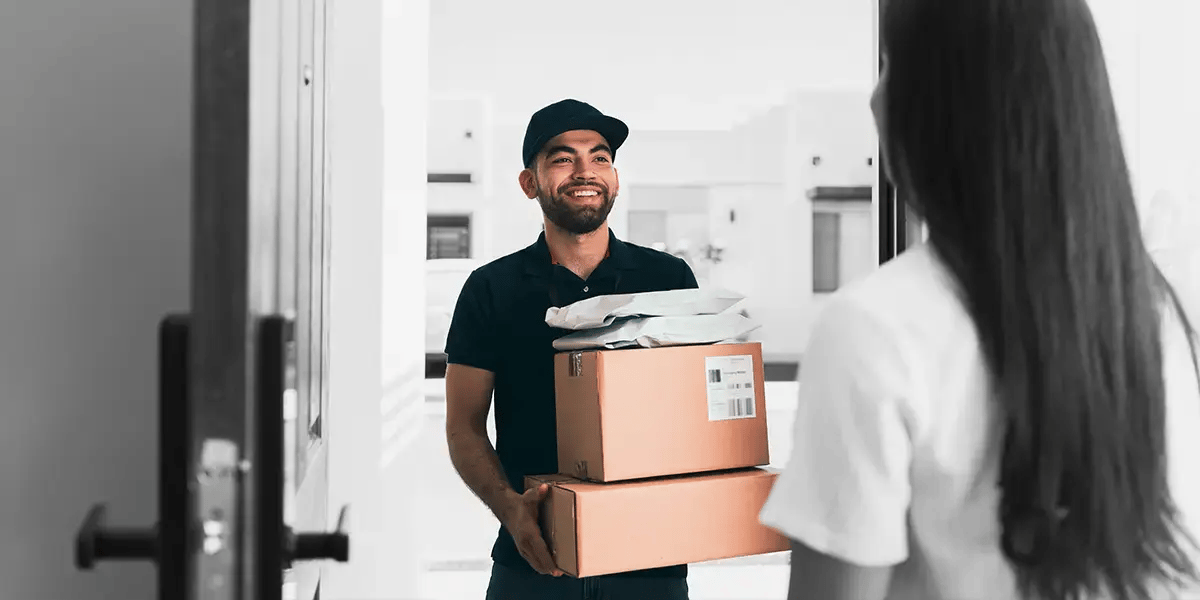
Last update: 08.07.2025
In this blog:
- Intro
- Last mile delivery: the final step with time and cost implications
- Last mile logistics: driving efficiency, cost savings, and customer retention
- Challenges in last mile delivery: time and cost considerations
- Leveraging technology for last mile efficiency and customer satisfaction
- Data-driven strategies for last mile success
- Further reading: Last Mile FAQs
Intro
Last mile logistics refer to coordinating parcels travelling from A to B. Meanwhile, last mile delivery refers to meeting customers’ expectations again and again.
Understanding the differences between last mile logistics and last mile delivery is nuanced, but crucial. Last mile logistics refer to coordinating parcels travelling from A to B.
Meanwhile, last mile delivery refers to meeting customers’ expectations again and again. These terms encompass various aspects of the delivery process, impacting delivery time, costs, and customer retention. In planning effective delivery strategies, retailers and web shops need to think in terms of both.
Last mile delivery: the final step with time and cost implications
Last mile delivery is the critical last step of the shipping process, transporting goods from a transportation hub or distribution center to the final destination, typically the customer's doorstep. Ensuring prompt delivery time is vital in meeting customer expectations.
Industry data suggests that efficient last mile delivery can lead to substantial time savings, with some studies showing up to a 30% reduction in delivery times when streamlined last-mile logistics are implemented.
Last mile logistics: driving efficiency, cost savings, and customer retention
Last-mile logistics encompasses a broader set of activities to enhance the last-mile delivery process, including planning, coordination, and optimization. Effective last mile logistics can significantly impact costs and customer retention. Studies have shown that companies investing in efficient last mile logistics experience up to a 15% reduction in delivery costs.
Additionally, seamless last mile delivery has a direct correlation with improved customer retention rates, with businesses reporting up to a 20% increase in customer satisfaction and loyalty when their last mile logistics are optimized.
Challenges in last mile delivery: time and cost considerations
Last mile delivery poses several challenges, such as navigating congested urban areas, meeting specific delivery time windows, and managing rising transportation costs.
However, with effective last mile logistics, these challenges can be mitigated. By utilizing advanced route optimization algorithms, businesses have seen a reduction in travel time by up to 40%, resulting in significant cost savings.
Leveraging technology for last mile efficiency and customer satisfaction
Technology plays a pivotal role in both last mile logistics and last mile delivery. Real-time tracking and monitoring systems enable businesses to have better visibility into their delivery operations, leading to improved efficiency.
The implementation of technology-driven solutions has shown a reduction in missed deliveries by up to 30%, resulting in enhanced customer satisfaction and retention rates.
Data-driven strategies for last mile success
Businesses must embrace data-driven strategies to optimize last mile logistics and delivery. Leveraging data analytics, companies can identify patterns, predict demand, and plan more effectively, ensuring efficient and cost-effective last mile delivery. Studies indicate that organizations adopting data-driven approaches achieve up to a 25% reduction in overall last mile delivery costs.
Similar as the two terms appear, there are important differences between them. Optimized last mile logistics can yield substantial time savings, cost reductions, and improved customer retention. By investing in technology-driven solutions, embracing data-driven strategies, and streamlining last mile delivery operations, businesses can gain a competitive advantage in the marketplace and deliver exceptional customer experiences.
It’s all in the delivery
From checkout to emissions, nShift gives you full control of delivery management at every step — with branded experiences, smarter shipping, and access to 1,000+ carriers.
Explore the nShift platformFurther reading: Last Mile FAQs
What are the biggest challenges in last‑mile delivery?
Key challenges include traffic congestion, complex delivery routes, frequent small delivery stops, inefficient routing, and unpredictable weather or road conditions—all of which drive up costs and delay deliveries.
Why is last‑mile delivery so expensive?
The final leg accounts for up to 50% of total delivery costs due to low vehicle utilization, fuel, labor, and high rates of failed or repeat deliveries.
How does technology optimize last‑mile delivery?
Platforms like route‑planning software, real‑time GPS tracking, and mobile apps help streamline dispatch, reduce mileage, and improve transparency—leading to faster, more reliable, and cost‑effective deliveries.
What’s the role of route optimization?
Dynamic algorithms account for traffic, delivery windows, and driver availability—minimizing travel distance and time, reducing fuel use, and boosting delivery density per route.
How do companies maintain customer satisfaction in last‑mile?
They provide ETA tracking, flexible delivery slots, proactive communication on delays, and options like parcel lockers or in‑store pickups to enhance convenience and trust.
What strategies reduce delivery costs?
Adopting micro‑fulfillment centers, crowd shipping (leveraging local gig drivers), shared vehicle networks, and eco‑friendly transport (e‑bikes, EVs) helps cut fuel, labor, and infrastructure spending.
How is sustainability integrated into last‑mile delivery?
Companies increasingly use e‑bikes and electric vehicles to reduce emissions. For instance, DHL’s deployment cut CO₂ emissions by 1 million metric tons in 2022.
What solutions exist for failed or missed deliveries?
Implementing better address validation, richer location data, autonomous and pickup‑point delivery options (parcel lockers), and driver training all reduce failed attempts and increase first‑try success.
What emerging trends are shaping last‑mile logistics?
Trends include crowd shipping models, autonomous delivery vehicles (drones, self‑driving vans), smart batching with AI, and expanding micro‑fulfillment hubs to shorten delivery distances.
How do companies deal with unexpected disruptions?
By using contingency routing tools, rerouting via alternate paths, maintaining transparent communication with customers, and keeping spare fleet capacity or third‑party partners on standby.

Author
Gary Carlile
EVP of Customer Growth
Gary Carlile is the Executive VP of Customer Growth at nShift responsible for the management of the Global Strategic team. He is highly experienced in Carrier & Delivery management, SaaS technology, Logistics & Supply Chain and eCommerce fulfilment operations.

About the author





